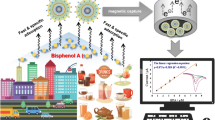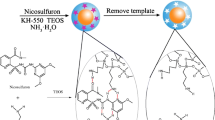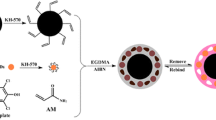Abstract
The main aim of this work was to develop a magnetic molecularly imprinted polymer (MMIP)-based quantum dots electrochemiluminescent (ECL) probe for the ultrasensitive and highly selective detection of bisphenol A (BPA). The prepared core-shell Fe3O4@SiO2 exhibited superparamagnetic properties, making them easy to separate. The MIP was fabricated by the self-polymerization of dopamine on the surface of amine-terminated Fe3O4@SiO2 (Fe3O4@SiO2-NH2) magnetic nanoparticles and doped with quantum dots (QDs) to form an ECL system. The ECL intensity decrease with the concentration of BPA increased, due to the BPA molecules occupied molecularly imprinted sites and blocked the strong ECL emission of QDs. The prepared ECL sensor performed satisfactorily in the detection of BPA, with a wide linear range from 10− 4 to 10− 9 mol L− 1 and a low detection limit of 3.4 × 10− 10 mol L− 1 (S/N = 3). The recoveries of BPA achieved were in the range 96%–107% in the detection of actual water samples. The proposed ECL sensor displayed high sensitivity and stability, and may provide an approach for determining other important analytes.




Similar content being viewed by others
References
Dadkhah S, Ziaei E, Mehdinia A, Baradaran Kayyal T, Jabbari AJ (2016) A glassy carbon electrode modified with amino-functionalized graphene oxide and molecularly imprinted polymer for electrochemical sensing of bisphenol A. Microchim Acta 183(6):1933–1941
Deng H, Li X, Peng Q, Wang X, Chen J, Li YD (2005) Monodisperse magnetic single-crystal ferrite microspheres. Angew Chem Int Ed 44:2782–2785
Fernandez MAM, Andre LC, Cardeal ZL (2017) Hollow fiber liquid-phase microextraction-gas chromatography-mass spectrometry method to analyze bisphenol A and other plasticizer metabolites. J Chromatogr A 1481:31–36
Freitas JM, Wachter N, Rocha-Filho RC (2020) Determination of bisphenol S, simultaneously to bisphenol A in different water matrices or solely in electrolyzed solutions, using a cathodically pretreated boron-doped diamond electrode. Talanta 217:121041
Jiao M, Jie GF, Tan L, Niu SY (2017) AgNPs-3D nanostructure enhanced electrochemiluminescence of CdSe quantum dot coupled with strand displacement amplification for sensitive biosensing of DNA. Anal Chim Acta 983:166–172
Jie G, Chen K, Wang X, Lu ZK (2016) Dual-stabilizer-capped CdSe quantum dots for “Off–On” electrochemiluminescence biosensing of thrombin by target-triggered multiple amplification. RSC Adv 6(3):2065–2071
Ke R, Zhang XM, Wang L, Zhang CY, Zhang S, Mao CJ, Niu HL, Song J, Jin BK, Tian YP (2015) Electrochemiluminescence sensor based on Graphene Oxide/Polypyrrole/CdSe nanocomposites. J Alloys Compd 622:1027–1032
Li YG, Gao Y, Cao Y, Li H (2012) Electrochemical sensor for bisphenol A determination based on MWCNT/melamine complex modified GCE. Sensor Actu B 171:726–733
Li ZH, Zhang WQ, Shan BQ (2019) The effects of urbanization and rainfall on the distribution of, and risks from, phenolic environmental estrogens in river sediment. Environ Pollut 250:1010–1018
Liu JY, Martin JW (2017) Prolonged exposure to bisphenol A from single dermal contact events. Environ Sci Technol 51(17):9940–9949
Liu Y, Li HF, Lin JM (2009) Magnetic solid-phase extraction based on octadecyl functionalization of monodisperse magnetic ferrite microspheres for the determination of polycyclic aromatic hydrocarbons in aqueous samples coupled with gas chromatography-mass spectrometry. Talanta 77(3):1037–1042
Liu SF, Zhang X, Yu YM, Zou GZ (2014) A Monochromatic electrochemiluminescence sensing strategy for dopamine with dual-stabilizers-capped CdSe quantum dots as emitters. Anal Chem 86(5):2784–2788
Lu SL, Cheng GX, Zhang HG, Pang XG (2006) Preparation and characteristics of Tryptophan-imprinted Fe3O4/P(TRIM) composite microspheres with magnetic susceptibility by inverse emulsion–suspension polymerization. J Appl Polym Sci 99(6):3241–3250
Mao Y, Bao Y, Han D, Li F, Niu L (2012) Efficient one-pot synthesis of molecularly imprinted silica nanospheres embedded carbon dots for fluorescent dopamine optosensing. Biosens Bioelectron 38(1):55–60
Peng CF, Pan N, Xie ZJ, Liu L, Xiang J, Liu C (2016) Determination of bisphenol A by a gold nanoflower enhanced enzyme-linked immunosorbent assay. Anal Lett 49(10):1492–1501
Peng H, Liu P, Wu W, Chen W, Meng X, Lin X, Liu A (2019) Facile electrochemiluminescence sensing platform based on water-soluble tungsten oxide quantum dots for ultrasensitive detection of dopamine released by cells. Anal Chim Acta 1065:21–28
Wang X, Lu X, Wu L, Chen J (2015) 3D metal-organic framework as highly efficient biosensing platform for ultrasensitive and rapid detection of bisphenol A. Biosens Bioelectron 65:295–301
Wang S, Liu F, Wu W, Hu Y, Liao R, Chen G, Wang J, Li J (2018) Migration and health risks of nonylphenol and bisphenol a in soil-winter wheat systems with long-term reclaimed water irrigation. Ecotox Environ Safe 158:28–36
Watabe Y, Kondo T, Imai H, Morita M, Tanaka N, Haginaka J, Hosoya K (2004) Improved detectability with a polymer-based trapping device in rapid HPLC analysis for ultra-low levels of bisphenol A (BPA) in environmental samples. Anal Sci 20(1):133–137
Xu XQ, Deng CH, Gao MX, Yu WJ, Yang PY, Zhang XM (2006) Synthesis of magnetic microspheres with immobilized metal Ions for enrichment and direct determination of phosphopeptides by matrix-assisted laser desorption ionization mass spectrometry. Adv Mater 18(24):3289–3293
Yao GH, Liang RP, Huang CF, Wang Y, Qiu JD (2013) A surface plasmon resonance sensor based on magnetic molecularly imprinted polymers amplification for pesticide recognition. Anal Chem 85(24):11944–11951
Yin H, Cui L, Chen Q, Shi W, Ai S, Zhu L, Lu LJ (2011) Amperometric determination of bisphenol A in milk using PAMAM–Fe3O4 modified glassy carbon electrode. Food Chem 125(3):1097–1103
Zhao WR, Xu YH, Kang TF, Zhang X, Liu H, Ming AJ, Cheng SY, Wei F (2020) Sandwich magnetically imprinted immunosensor for electrochemiluminescence ultrasensing diethylstilbestrol based on enhanced luminescence of Ru@SiO2 by CdTe@ZnS quantum dots. Biosens Bioelectron 155:112102
Acknowledgements
We greatly appreciate the support of the National Natural Science Foundation of China (21505001), the Major Programs of Science and Technology of Anhui Province (201903a06020003).
Author information
Authors and Affiliations
Corresponding author
Additional information
Publisher’s Note
Springer Nature remains neutral with regard to jurisdictional claims in published maps and institutional affiliations.
Rights and permissions
About this article
Cite this article
Shi, J., Zhang, X., Zhang, Q. et al. Ultrasensitive and Highly Selective Detection of Bisphenol a Using Core-Shell Magnetic Molecularly Imprinted Quantum Dots Electrochemiluminescent Probe. Bull Environ Contam Toxicol 108, 379–385 (2022). https://doi.org/10.1007/s00128-021-03351-z
Received:
Accepted:
Published:
Issue Date:
DOI: https://doi.org/10.1007/s00128-021-03351-z




